
I’m highly excited about the upcoming virtual reality and augmented reality technology explosion. It seems new products are being announced all the time, but none of them are in the hands of the general consumer yet. PAX Prime gave me the perfect opportunity to try out three different devices: Oculus Rift, HTC Vive, and Cast AR. Here are my thoughts on each of them.
Oculus Rift and Gear VR
Oculus Rift is the VR device that led the wave of excitement back to consumer 3D after a highly successful Kickstarter. As the granddaddy of the field, there were a number of games using it on display at PAX. In addition, Samsung has created the Gear VR, a partnership with Oculus where you can mount a Samsung phone in an Oculus headset to create a head-mounted VR device without the need for a PC. I played the following games using a mix of Oculus Rift and Gear VR devices.
Minority Media: Time Machine VR
A VR-only adventure and exploration game, Time Machine VR puts you in the role of a time travelling scientist. A virus is destroying mankind and you must return to pre-history to find the key to humanity’s salvation in the DNA of ancient creatures. Practically, this means you pilot a small ship around dinosaurs and try not to get eaten.
The game had quite a level of immersion. Sitting in my spherical vehicle, I maneuvered in three dimensions while turning my head to find my next objective. Goals typically involved getting close to dangerous beasts to get sensor readings or obtain DNA samples. To help with this, you have the ability to slow time down, but the effect only lasts so long. I was fearful of being preyed upon and constantly swung my head around to see if there was a dinosaur “on my six.”
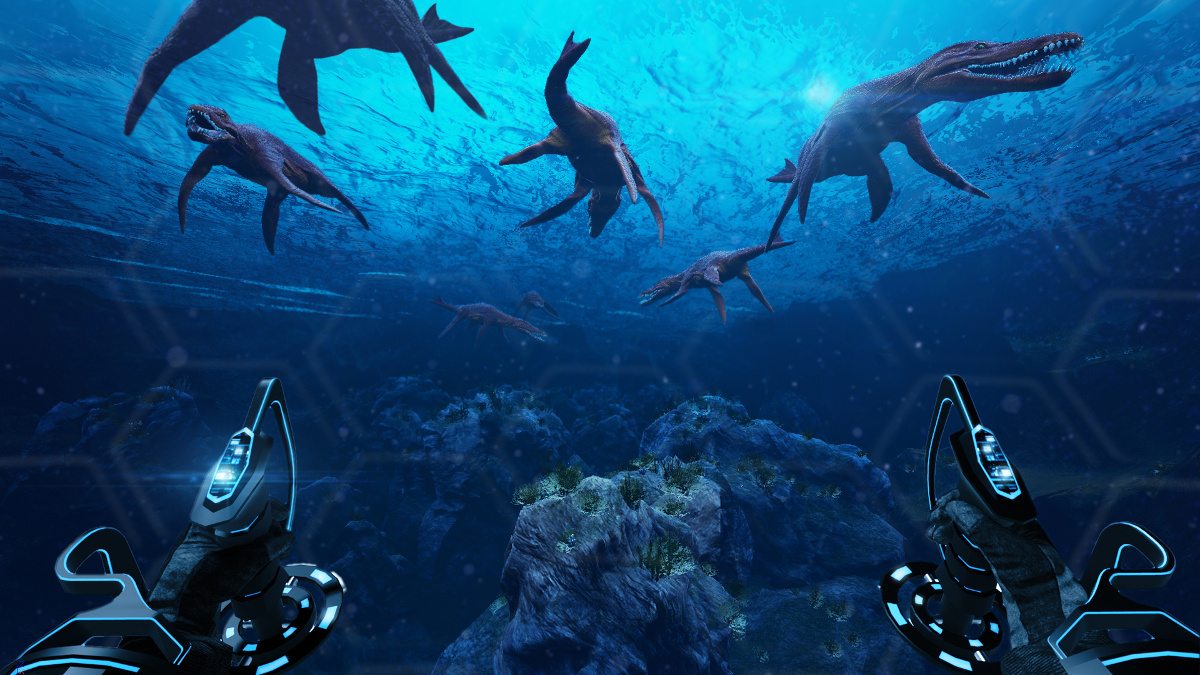
Minority Media has created one of the first true Oculus VR games and I’m looking forward to experiencing the complete product. Time Machine VR is available on Steam as an Early Access Game to anyone with an Oculus Dev Kit 2. There is a ten-minute demo, and if you like what you see, the full game (in development) can be had for $14.99 USD.
E McNeill: Darknet and Tactera
Indie developer E McNeill backed the original Oculus Rift Kickstarter and won the IndieCade + Oculus VR Jam in 2013. His entry, Ciess, has since gone on to become Darknet, a puzzle strategy game set in cyberspace as imagined by Hollywood of the ’80s and ’90s. He showed me Darknet as well as a tabletop real-time strategy game, Tactera.
I played Darknet standing up. It’s a necessity, really, as my point of view was the inside of a sphere. Projected onto its inner surface were various glowing circles connected by lines to form a web. The artwork truly did look like a ’90s hacker movie! The demo on display vastly simplified the gameplay, but the puzzle was quite intriguing: you choose nodes at which to inject viruses, and they spread out until they hit an anti-virus node. You have a limited number of viruses to use in your effort to reach the core objective. As the puzzle literally envelops you, you have to apply problem-solving skills in a way not often experienced, thinking in three dimensions and remembering that part of the puzzle is not in view. The game has strategy at the higher network layer as well, with the player using items purchased with money from successful hacks and deciding which missions to attempt.

Tactera, the result of a two-month game jam, is a tabletop real-time strategy game. While still early in development, I was able to play a demo McNeill had put together for PAX. Wearing the Gear VR, I sat in a war room, a projector above my head beaming a three-dimensional battlefield in front of me. Using the controller, I selected various structures, summoning units and sending them towards targets on the enemy side of the map. With aircraft flying above (at eye level), shots firing across the space, and the action sprawling in front of me, it very much felt like I was a tabletop general. I’ve been very excited about this use for VR for quite some time, and I think McNeill’s take on it could serve as a point of reference for future real-time strategy games in VR.
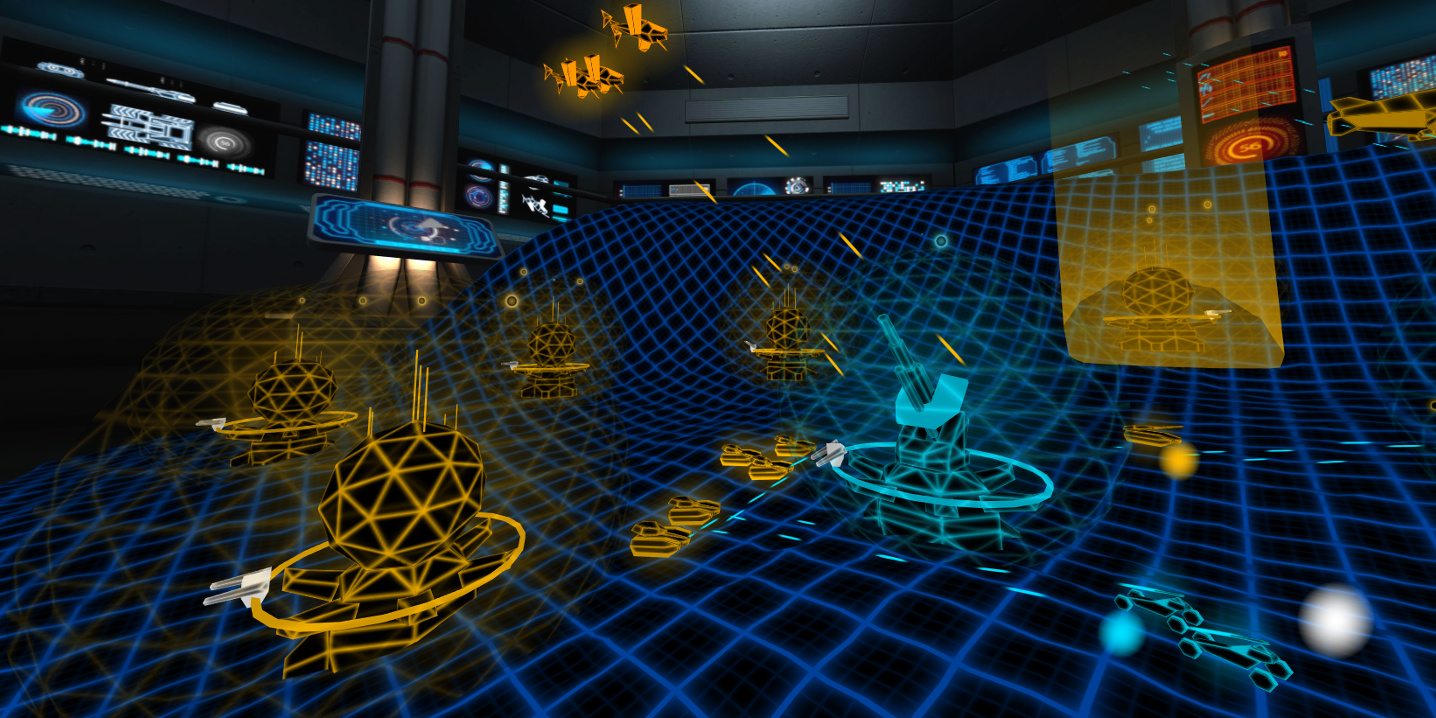
Steel Crate Games: Keep Talking and Nobody Explodes
Just because your view is closed off in virtual reality doesn’t mean you can’t have a party game! Keep Talking and Nobody Explodes is one of the most unique gaming experiences I have ever enjoyed. The player wearing the headset sits alone in a room. In front of them is a bomb in a briefcase. The bomb is covered in a number of controls that have to be manipulated to defuse it. As well, there can be other identifying information on the bomb, such as batteries and model or serial numbers.
The twist is that the other player (or players) are sitting physically close with a paper manual containing the instructions to defuse the bomb. For each element, they have to determine its configuration (are there three yellow wires? Is the fourth wire green?) and then tell the player what code to enter, what button to push, or what wire to cut. (Hint: red is not always the right answer.) Incorrect attempts take away some time and speed up the clock, adding further stress and urgency to the situation.
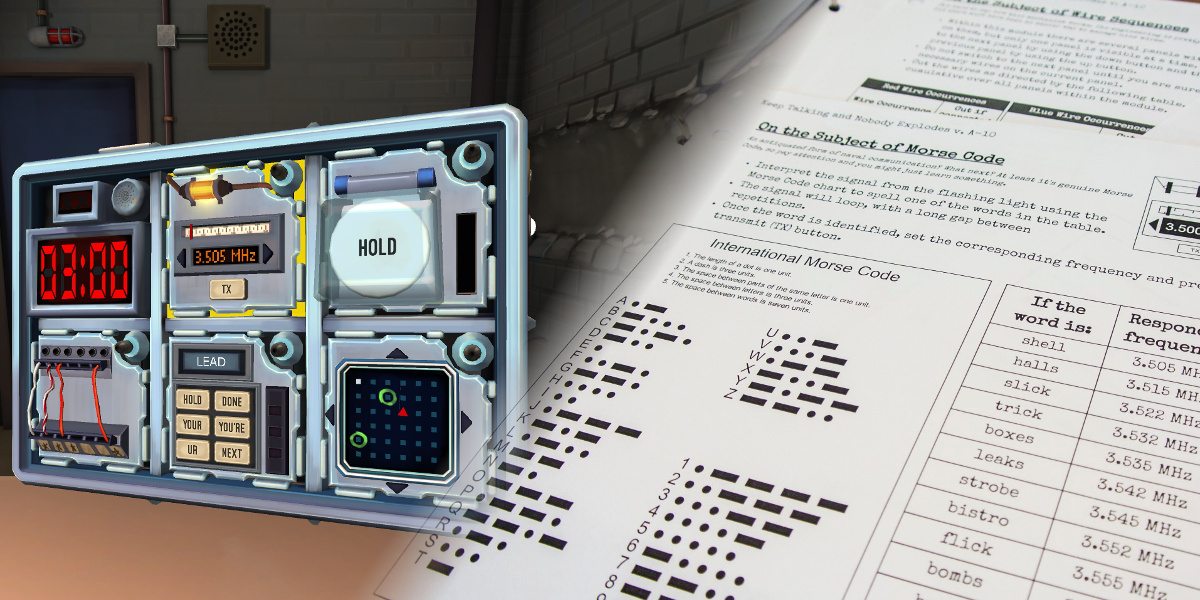
I had the good fortune of finding the demo in a quiet theater, with a number of people in the crowd creating a party-game atmosphere. The crowd watched with bated breath as the team on stage worked frantically. When mistakes were made, they were often apparent to everyone (except for the players), making for some truly great moments. When bombs were defused, the group cheered, but the explosions were usually funnier. I successfully defused a bomb, only to go and flub helping someone else, but I had a blast no matter my role: as defuser, helper, or just watching the game be played.
Keep Talking and Nobody Explodes has filled a niche I didn’t even know existed in the VR space, and I want a VR headset just to break this out at a party. You can get it on Steam, and you can even play it without a headset, but trust me, if you can, experience this game in virtual reality.
HTC Vive (SteamVR)
How had I not heard about the HTC Vive? A partnership between HTC and Steam, the key differentiator is that the Vive is set up to allow the user to move in a physical space; rather than being stuck in a chair, you’re able to walk around a room up to 15ft x 15ft. This is accomplished with a 3D spatial laser-tracking system called “Lighthouse”. Lighthouse consists of a pair of base stations placed on opposite corners of the room that have both a bank of infrared LEDs as well as two spinning IR lasers. The VR headset and hand controllers have infrared sensors that detect these emissions which are relayed back to the computer. The system then calculates the position and orientation of both the headset and hand controllers. In my experience this worked flawlessly, with my virtual manipulators appearing exactly where I expected to see them in the virtual space and virtual room borders helpfully signalling the location of physical walls. The power of this setup was proven to me in the demo for Final Approach.
Phaser Lock Interactive – Final Approach
Remember Flight Control on your smartphone? Final Approach executes that experience in a fully immersive 3D world. I stood as a giant in front of the playing area, an island paradise with gorgeously rendered rocky cliffs, lush vegetation, and beaches. As the HTC Vive allows the player to walk around, I was able to enter the middle of the scene, having the landscape surround me. As aircraft approached I was able to easily reach out and touch them, then draw a route in three dimensions to guide them to their runway or pad.
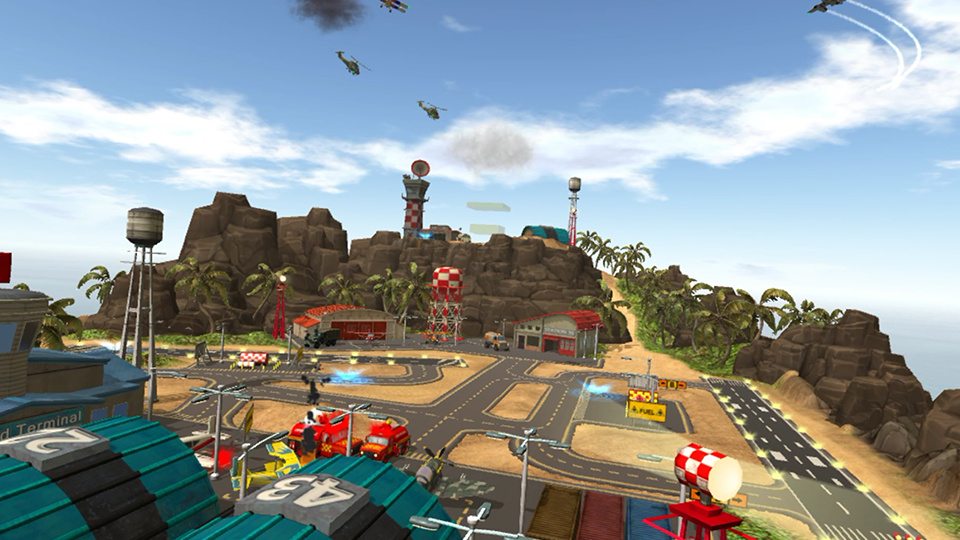
Just as I was getting the hang of it, the game threw an unexpected twist at me: an aircraft was on fire. The game zoomed me in so that I was now standing on the runway. From there, I took a fire extinguisher and put out the engine fire. What happened next though is what truly sold me on the technology: with the fire out, the aircraft restarted its engines and began to advance.
Some background: I work in aviation and have spent some time servicing aircraft on a flightline. A moving aircraft is to be respected. A close moving aircraft where you’re not in communication with the pilot is to be feared. My reflexes got the best of me and I found myself ducking under the plane’s wing; I barely managed to stifle a tiny scream. The simulation had me convinced; I was in that world.
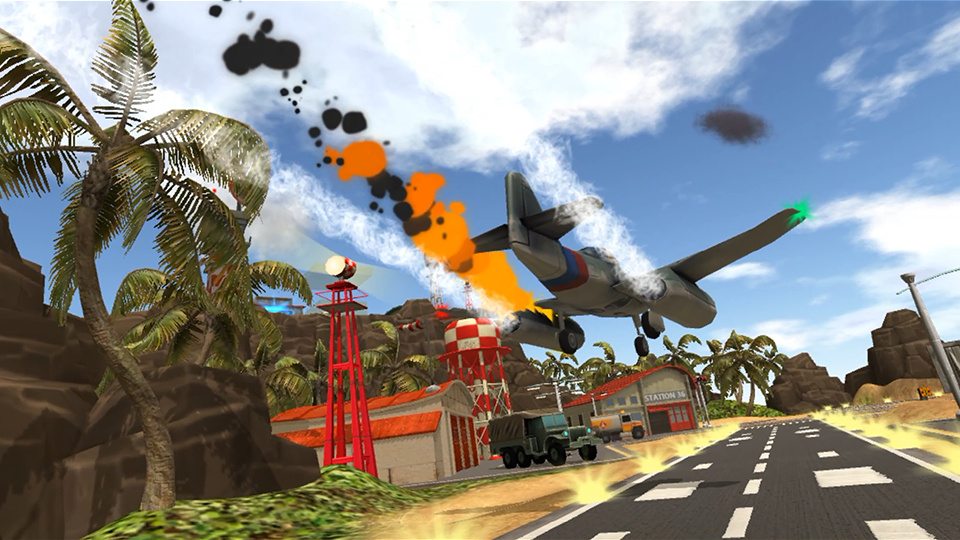
Final Approach will be a launch title on the HTC Vive (coming to Oculus at a later date), and demonstrates the power of an interactive virtual reality environment. During my interview with E McNeill, he mentioned that he could do more with Tactera on Vive, and I’m excited to see what he’ll do with this technology.
Cast AR
While virtual reality gets a lot of interest, I think augmented reality (AR) may have even more potential. Cast AR was the product of a very successful Kickstarter and has the goal of bringing 3D projections away from your computer to any space in which you want to work or play, while allowing multiple people to share that space simultaneously. It does this with two key components. First, a special pair of glasses: just like with 3D from your television, each eye is presented with a different view via an active shutter. However, the innovation here is the image source. The glasses themselves have two projectors, one for each eye, that shine the image onto the surface. That surface simply needs to be covered in the second component: a retro-reflective sheeting material. This is the same kind of material used in road signage; it’s made to reflect almost all of the light directly back to the source of emission. What this means is that when you look at the play area, your own personal 3D hologram is created on the table that no one else can see! The system includes a controller, dubbed the castAR wand, that is also tracked in the physical space, allowing it to interact with the virtual world.

The team’s focus at this point is very much on producing a standalone system. While the hardware can be connected to a high-end PC for more advanced rendering, the glasses themselves can contain and play games. This is likely because they are heavily focused on child and family-friendly experiences, at least for their initial launch. During my demo time, I played an update of Battleship, which may not have been that exciting for me, but certainly demonstrated what the tech is capable of: my opponent and I played, looking at the same shared table, but our hidden ships could not be seen by each other until they were hit. I also got to experience a modern take on Jenga; a never-ending stack of blocks came out of the mat, and my controller morphed into a light sabre, allowing me to poke and slash to my heart’s content. That was definitely cool.
There are so many uses I can imagine for this technology, but the one that excites the GeekDad in me most are shared board game experiences. Gaming should be more natural than with virtual reality as you can still see the real people who are sitting at the table with you. Moreover, Cast AR will give game designers an easy way to create hidden information systems: what you see in your game no longer has to be what all the other players see. How great would this be for a role-playing game? We actually discussed that for a bit, and one of the developers started talking about being in a dungeon, noting that the party’s dwarf, with infravision, would be given a better view than the other players had. So clearly this is something they’ve been thinking about!

A nice touch is that Cast AR can even be converted to a full virtual reality device with the addition of a reflective clip-on lens that returns the projection to the user from the glasses directly. My only concern from the demo was that the image was a little washed out; the room had to be quite dark to be able to use the system effectively. However, the hardware I experienced was early developer hardware; the team told me that through some minor positioning changes that they expect to make the system two and a half times brighter for the developer kit before CES 2016. Learn more about Cast AR on their site.
Which Tech Was Best?
Virtual and augmented reality is coming our way fast, and it looks awesome. The technologies I got to see aren’t even necessarily competing with one another. Oculus Rift provides a traditional gaming experience while seated, while HTC Vive brings immersion to a whole new level by allowing motion throughout a physical space. CastAR promises to add 3D viewports where no screens exist, and could generate an entirely new way of playing board games. The developers tell me that the reflective fabric can be bought for a dollar per square foot. Holodeck, anyone?
As for the Samsung Gear VR versus a true Oculus Rift? I didn’t notice a difference in any of the games I played. I would expect that the Gear VR wouldn’t have the same processing power as running a game on your PC with an Oculus Rift, but that didn’t prove to be a factor for anything I saw on display at PAX Prime.
Conveying just how great these technologies and games are is difficult as you really need to wear it to “get” it. My advice at this point is to get in those lines early at your next convention. Like the Matrix, you need to see it for yourself.
Edit 31 Oct: Clarifications to HTC Vive’s Lighthouse tracking technology were added.




I think CastAR (maybe Samsung Gear) has the best promise as a research tool. For example, the rubber hand body ownership / resonance can be seen here:
http://www.jove.com/video/50530/the-crossmodal-congruency-task-as-means-to-obtain-an-objective
And of course for virtual real porn